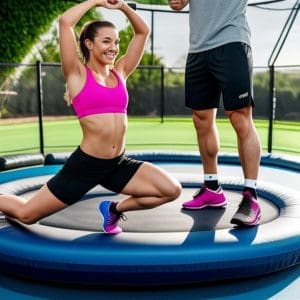In the quest for stronger, more toned legs, many fitness enthusiasts are turning to an unconventional yet highly effective method—trampolining. This article explores the significance of leg muscles, the benefits of trampolining, and how this fun activity can contribute to a sculpted lower body. For a more general introduction to trampolines and trampolining read our guide here.
Importance of Leg Muscles
Our legs are the foundation of our body, supporting us in daily activities and physical pursuits. Developing strong leg muscles not only enhances stability but also contributes to overall athleticism.
Why Choose a Trampoline for Leg Muscles
Choosing a trampoline for leg muscles is a wise and enjoyable fitness decision, offering a unique set of benefits that cater specifically to lower body strength. Here’s why you should consider incorporating trampolining into your leg workout routine:
- Low-Impact Exercise: Trampolining provides a low-impact alternative to traditional leg exercises, reducing stress on joints while effectively engaging leg muscles.
- Cardiovascular Benefits: Bouncing on a trampoline elevates your heart rate, contributing to improved cardiovascular health and endurance.
- Full Leg Engagement: The dynamic movements of trampolining engage various leg muscles simultaneously, including quadriceps, hamstrings, calves, and glutes.
- Enhanced Flexibility: The constant change in body position and bouncing motion promotes flexibility, contributing to better overall leg mobility.
- Fun and Motivating: The enjoyable nature of trampolining makes leg workouts more engaging, increasing motivation for consistent exercise.
Incorporating a trampoline into your fitness routine not only targets leg muscles comprehensively but also add an element of fun, ensuring a sustainable and enjoyable approach to leg muscle development.

Leg workouts on a trampoline
What Leg Muscles does Trampolining Engage?
Trampolining engages a comprehensive array of leg muscles, providing a dynamic and effective lower body workout. The primary leg muscles involved in trampolining include:
- Quadriceps (Thigh Muscles): Responsible for extending the knee during the upward phase of a jump.
- Hamstrings (Back of the Thigh): Actively engaged during the downward phase of a jump, controlling the bending of the knee.
- Calves (Gastrocnemius and Soleus): Work together to point and flex the foot, crucial for stability and balance on the trampoline.
- Glutes (Buttock Muscles): Contract during jumps and provide stability during landing, contributing to overall leg strength.
The dynamic movements on a trampoline ensure a holistic workout, targeting these muscles simultaneously for comprehensive leg muscle engagement.

What Leg Muscles are Worked Out on a Trampoline
Will Jumping on a Trampoline Tone My legs?
Yes, jumping on a trampoline is an effective way to tone your legs and buttocks. The unique nature of trampolining engages various leg muscles, contributing to muscle tone and strength. Here’s how:
- Engages Multiple Muscles: Jumping on a trampoline involves a combination of quadriceps, hamstrings, calves, and glutes. The continuous bouncing action activates and tones these muscles simultaneously.
- Resistance Training: The upward push against gravity during each jump provides a form of resistance training. This helps build muscle strength in your legs, promoting a toned appearance.
- Improves Circulation: The cardiovascular benefits of trampolining enhance blood circulation, promoting overall leg health and contributing to a more toned and defined lower body.
- Enhances Flexibility: The dynamic movements on a trampoline require flexibility in the legs, promoting improved range of motion and muscle elongation, further contributing to toned muscles.
- Low-Impact Nature: Trampolining is a low-impact exercise, reducing stress on joints while effectively engaging leg muscles. This allows for consistent and sustainable leg toning without excessive strain.
In summary, incorporating trampolining into your fitness routine provides a fun and efficient way to tone your legs and bum, offering a holistic approach to lower body muscle development.

Types of Trampolines for Leg Workouts & Muscle Gains
Types of Trampolines and The Best Trampoline Types for Leg Muscles
Discovering the right trampoline is pivotal in shaping an effective leg muscle development routine. In this exploration, we delve into the various types of trampolines, dissecting their unique attributes and identifying the best options for sculpting robust leg muscles. From outdoor expansiveness to indoor precision, this guide navigates through trampoline types to help you make an informed choice for a dynamic and targeted leg workout. Uncover the optimal trampoline for your leg muscle journey in this insightful exploration.
Choosing the Right Trampoline for Leg Muscles
Selecting the appropriate trampoline is crucial for optimizing leg muscle engagement. The choice between indoor and outdoor trampolines is often influenced by space availability and personal preferences. However, the impact on leg muscles can vary, and understanding these nuances is essential for tailoring your workout.
Types of Trampolines and Leg Muscles Worked
To assist you in making an informed decision, let’s break down the types of trampolines and the specific leg muscles they target:
| Trampoline Type | Leg Muscles Worked |
| Outdoor | Quadriceps, Hamstrings, Calves, Glutes |
| Indoor | Quadriceps, Calves, Glutes |
Outdoor Trampolines
Outdoor trampolines provide a larger jumping surface, allowing for more expansive movements. This engages a broader range of leg muscles, including the quadriceps, hamstrings, calves, and glutes. The uneven terrain adds an element of challenge, enhancing muscle activation and promoting overall strength.
Indoor Trampolines
Indoor trampolines, often smaller in size, are suitable for individuals with limited outdoor space. While they primarily target the quadriceps, calves, and glutes, the controlled environment facilitates focused workouts. The smaller surface area can intensify muscle engagement, making indoor trampolines an effective option for leg muscle development.

Best types of trampolines for legs
Choosing the Right Size of Trampoline for Leg and Calve Muscles
Selecting the right size of trampoline is a crucial aspect of tailoring your workout for optimal leg and calf muscle engagement. Consider the following factors to ensure you make an informed decision:
- Jumping Surface Area: The size of the trampoline directly impacts the available jumping surface. Opt for a larger trampoline, ideally 10 feet trampoline or more in diameter, to allow for expansive movements that engage a wide range of leg muscles.
- Foot Placement Comfort: A spacious trampoline minimizes the risk of unintentional collisions with the frame. A size of 12 feet trampoline or more provides ample space for comfortable foot placement, reducing the likelihood of missteps and enhancing overall safety during workouts.
- Bounce Quality: Larger trampolines generally offer a smoother and more controlled bounce. A size ranging from 14 to 16 feet ensures consistent resistance, promoting effective muscle activation and contributing to a more rewarding leg and calf workout.
Choosing the right size ensures a dynamic trampolining experience that not only targets specific muscle groups but also maximizes the overall effectiveness of your leg and calf workouts.
Size and Safety Features
Navigating the realm of trampolines involves more than just size considerations; safety features are paramount. In the quest for optimal leg muscle development, selecting the right trampoline involves a thoughtful examination of its dimensions and safety attributes. Size matters, and a trampoline with an ample jumping surface is essential for effective leg workouts. However, our guide goes beyond size, emphasizing the significance of safety features. From enclosures to sturdy frames, we ensure your trampoline not only accommodates your fitness needs but also prioritizes the safety of your legs and joints. Join us as we delve into the intricacies of trampoline selection, ensuring that your fitness journey is not only effective but also safe and injury-free.
Trampoline Exercises for Legs
Embark on a journey to sculpt and strengthen your legs through the dynamic and engaging world of trampoline exercises. This guide explores a diverse array of exercises designed specifically to target and tone your leg muscles. From foundational bouncing techniques to advanced manoeuvres, discover how trampolining can transform your leg workout routine, adding an element of fun to your fitness journey while effectively enhancing the strength and definition of your lower body.
Basic Bounce
Discover simple yet effective trampoline exercises specifically designed to target and strengthen your leg muscles. The basic bounce is an excellent starting point for beginners.
Tips for Effective Leg Trampoline Workouts
Embarking on a journey to sculpt and strengthen your legs through trampolining? Unlock the full potential of your leg workout with these insightful tips. Whether you’re a beginner or a seasoned bouncer, discover effective strategies to maximize leg muscle engagement and elevate your trampoline workouts. From proper warm-up techniques to advanced bouncing methods, these tips will guide you towards a rewarding and impactful leg trampolining experience.
Warm-up and Cool Down
To maximize the benefits of trampolining for your leg muscles, incorporating proper warm-up and cool-down routines is crucial. We’ll provide easy-to-follow tips to ensure a well-rounded workout.
Safety Precautions for Leg Exercises on Trampolines
Ensuring a safe trampoline workout is paramount, especially when focusing on leg exercises. Implementing proper safety precautions not only safeguards against injuries but also enhances the effectiveness of your leg workout. From mastering landing techniques to using a well-maintained trampoline, these safety measures provide a secure foundation for your trampolining journey. Prioritize safety to make the most of your leg exercises on the trampoline, ensuring a healthy and enjoyable fitness experience.
Proper Landing Techniques
Safety is paramount when engaging in trampoline activities. Learn the correct landing techniques to prevent injuries and make your trampolining experience both enjoyable and secure.

Which exercises are best on a trampoline for legs
Best Trampoline Exercises for Legs & Leg Workouts
Fun and Engaging Trampoline Games for Leg Muscle Gain
Elevate your leg muscle gain with a touch of excitement by incorporating fun trampoline games into your workout routine. Experience the joy of bouncing while targeting and strengthening your leg muscles. From playful hopscotch challenges to dynamic games designed for leg muscle engagement, these activities not only make your workout enjoyable but also add a competitive and entertaining element to your trampolining sessions. Make leg day fun, engaging, and effective with these lively trampoline games.
Hopscotch Challenge
Trampolining isn’t limited to repetitive exercises. Spice up your routine with fun games like the hopscotch challenge, combining entertainment with fitness.
Professional Trainer Recommendations & Tips for Training Legs on a Trampoline
Gain invaluable insights from fitness professionals to elevate your trampolining routine for maximum leg muscle development. Expert advice is key to optimizing your workouts and achieving the best results.
Trainers emphasize the significance of incorporating High-Intensity Interval Training (HIIT) into your trampoline workouts for enhanced leg toning. Here are some professional tips to guide you:
- Varied Bouncing Techniques: Mix up your bouncing techniques, alternating between high and low-intensity jumps. This variation challenges different leg muscles and intensifies the workout.
- Interval Timing: Implement HIIT principles by incorporating short bursts of intense jumping followed by brief periods of rest. This not only boosts cardiovascular health but also accelerates leg muscle engagement.
- Incorporate Plyometrics: Integrate explosive movements like tuck jumps, jumping jacks, and scissor kicks. These plyometric exercises amplify the resistance on your leg muscles, promoting strength and definition.
- Focus on Form: Pay attention to your form during each jump. Maintain proper alignment and engage your core for stability. This ensures that your leg muscles are efficiently targeted and reduces the risk of injury.
- Combine Strength Exercises: Intersperse your trampoline session with strength exercises like squats, lunges, and leg lifts. These compound movements complement the dynamic nature of trampolining, fostering comprehensive leg muscle development.
Trainers underscore the importance of consistency and gradual progression. Start with shorter sessions, gradually increasing intensity and duration as your leg muscles adapt. By integrating these professional tips, you’ll harness the full potential of trampolining for optimal leg muscle development, transforming your routine into a dynamic and effective fitness experience.

focusing on legs for trampoline exercises
Frequently Asked Questions
Addressing Concerns About Safety and Impact on Joints
- Is trampolining safe for all ages? Trampolining is generally safe, but certain precautions should be taken for different age groups.
- Does trampolining have a negative impact on joints? Contrary to common belief, trampolining, when done correctly, can be gentle on the joints.
- How often should I trampoline for optimal leg muscle development? Find the ideal frequency to achieve the best results without overexerting your muscles.
- Can trampolining help with weight loss? Explore the connection between trampolining and weight loss and how it contributes to overall fitness.
- Are there specific exercises for targeting different leg muscles on a trampoline? Learn about various exercises that specifically target different muscles in the legs for a well-rounded workout.
Conclusion
In conclusion, trampolining offers a unique and enjoyable way to strengthen your leg muscles. The combination of fun, cardiovascular benefits, and community engagement makes it a holistic approach to fitness. Embrace the bounce and elevate your leg workout routine today!










